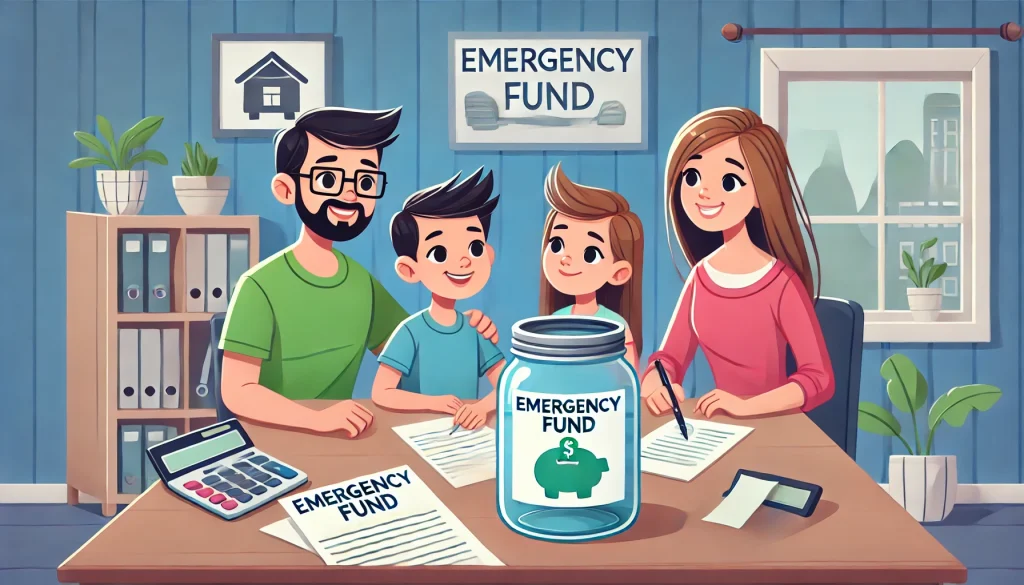Why an Emergency Fund is Essential for Financial Stability
An emergency fund serves as a crucial safety net, protecting you from unexpected financial setbacks like job loss, medical expenses, or urgent home repairs. Life is unpredictable, and no matter how well you plan your finances, unexpected events can throw your budget off course. Without an emergency fund, you could find yourself relying on high-interest debt, such as credit cards or personal loans, to cover these costs. Having a dedicated emergency fund ensures that you are financially prepared for life’s uncertainties, giving you peace of mind and helping you avoid financial stress. In this article, we’ll explore the importance of emergency funds and provide practical steps to help you build one.
What Is an Emergency Fund?

Definition of an Emergency Fund: Your Financial Safety Net
An emergency fund is a dedicated amount of money set aside to cover unexpected expenses, ensuring you can manage unforeseen financial challenges without resorting to high-interest debt. This fund is designed to be a financial buffer for unexpected events, such as medical bills, urgent home repairs, or job loss. It is different from savings for planned expenses like vacations, car purchases, or home renovations. Your emergency fund should only be accessed in true emergencies where an immediate need for cash arises, making it a key part of a solid financial plan.
Why You Need an Emergency Fund: Protecting Your Financial Health
Having an emergency fund is critical to maintaining financial stability, preventing you from falling into debt when life throws unexpected expenses your way. Without this safety net, many people are forced to rely on credit cards, loans, or even tap into long-term savings (such as retirement funds) to cover sudden costs. This can create a cycle of debt that is hard to escape. An emergency fund not only shields you from financial disaster but also reduces stress, allowing you to make better, more informed decisions in times of crisis.
How Much Should You Save for an Emergency Fund?
Determining the Right Emergency Fund Amount: Factors to Consider
The amount you need in your emergency fund depends on factors like your monthly expenses, job security, and personal financial situation. A good starting point is to calculate your basic monthly expenses, which include rent or mortgage payments, utilities, groceries, transportation, and other essential bills. From there, consider your job stability and financial obligations. If your job is stable and you have additional sources of income, you may feel comfortable with a smaller fund. However, if you are self-employed, a freelancer, or work in an industry with high volatility, you may want a larger cushion.
The 3-to-6 Month Rule: A General Guide for Emergency Fund Savings
Financial experts recommend saving 3 to 6 months’ worth of living expenses in your emergency fund, providing enough cushion to handle most common financial emergencies. For example, if your essential monthly expenses amount to $3,000, aim to save between $9,000 and $18,000 in your emergency fund.
Three months may be sufficient for individuals with stable income, a solid job, or dual-income households. On the other hand, if you are self-employed, work in a high-risk industry, or have variable income, saving closer to six months (or even more) may provide additional security. Ultimately, the goal is to create a buffer that allows you to cover expenses without stress during a financial emergency.
Steps to Build Your Emergency Fund
Start Small: Setting Achievable Savings Goals
Building an emergency fund can seem overwhelming, but starting with small, achievable savings goals will help you build momentum. You don’t need to save six months’ worth of expenses all at once. Instead, aim for an initial goal of $500 or $1,000 to cover minor emergencies like car repairs or small medical bills. Once you’ve reached this milestone, gradually increase your target.
Breaking down your larger savings goal into smaller steps makes it easier to stay motivated. For example, setting aside $50 per week or $200 per month may seem more manageable and will help your emergency fund grow steadily.
Create a Budget to Identify Extra Savings Opportunities
A well-planned budget helps you identify areas where you can cut back on spending and allocate more toward building your emergency fund. Begin by tracking your income and expenses to understand where your money is going each month. You may find opportunities to reduce discretionary spending, such as dining out less or canceling unused subscriptions.
Popular budgeting methods, such as the 50/30/20 rule (50% for needs, 30% for wants, 20% for savings and debt repayment) or zero-based budgeting, can be effective tools to prioritize savings. The key is to find a budget that works for your lifestyle while allowing room for regular contributions to your emergency fund.
Prioritize Consistent Contributions: Building the Habit of Saving
Consistently contributing to your emergency fund, even in small amounts, is key to ensuring it grows steadily over time. Regular savings contributions, no matter how small, add up quickly and help you establish a habit of saving. If possible, automate your savings by setting up direct deposits from your paycheck into a separate emergency fund account. This “set-it-and-forget-it” approach ensures that you’re consistently saving without having to think about it.
For example, you could automate a transfer of $100 from your checking account to your savings account every payday. Over time, this will help you build a robust emergency fund without the temptation to spend the money elsewhere.
Look for Extra Income Sources to Boost Your Savings
Finding ways to generate extra income can significantly accelerate the growth of your emergency fund, helping you reach your savings goal faster. Consider taking on side gigs, freelancing, or selling items you no longer need. Even short-term efforts to increase your income can make a big difference in how quickly you can build your fund.
Additionally, consider directing bonuses, tax refunds, or other unexpected windfalls directly into your emergency fund. This will give your savings a boost without affecting your day-to-day budget.
Where to Keep Your Emergency Fund
Choosing the Right Account for Your Emergency Fund: Liquidity and Safety
The ideal place for your emergency fund is an account that offers both easy access and security, ensuring you can withdraw the money quickly when needed. High-yield savings accounts and money market accounts are popular options for emergency funds because they provide liquidity while earning some interest. While these accounts may not offer high returns, they prioritize accessibility, which is essential for emergencies.
It’s important to avoid putting your emergency fund in accounts that are difficult to access or risky investments, such as stocks or long-term CDs, which may penalize you for early withdrawals or lose value in a downturn.
Avoiding Risky Investments for Emergency Funds
While it may be tempting to invest your emergency fund to earn higher returns, the priority should always be liquidity and low risk. Investments like stocks, bonds, or mutual funds can fluctuate in value, and you don’t want to be forced to sell assets during a market downturn just to cover an emergency expense.
Instead, keep your emergency fund in low-risk accounts such as high-yield savings accounts or money market accounts. These options allow you to access your money when you need it, without the risk of losing value due to market volatility.
When and How to Use Your Emergency Fund
Knowing When It’s Time to Tap into Your Emergency Fund
An emergency fund is meant for true financial emergencies, so it’s important to recognize when it’s appropriate to use it and when it’s better to rely on other resources. Emergencies that justify tapping into your fund include unexpected medical expenses, major car repairs, urgent home repairs, or sudden job loss.
However, it’s important to avoid using your emergency fund for non-essential expenses like vacations, shopping, or dining out. By setting clear boundaries for what constitutes an emergency, you’ll ensure that your fund remains intact for genuine crises.
Rebuilding Your Emergency Fund After Use
After dipping into your emergency fund, it’s essential to have a plan in place to replenish it as soon as possible. Rebuilding your emergency fund should become a priority until you’ve restored it to its full amount. Adjust your budget, cut back on discretionary spending, or increase your savings contributions temporarily to replenish the fund faster.
Additionally, if you receive extra income through a bonus, tax refund, or side gig, consider putting that money directly into your emergency fund to expedite the rebuilding process.
Common Mistakes to Avoid When Building an Emergency Fund
Neglecting to Save Regularly: The Danger of Inconsistency
One of the most common mistakes is neglecting to save regularly, which can prevent your emergency fund from growing to its full potential. While it may seem difficult to save consistently, even small, regular contributions will add up over time. If you skip too many contributions, you risk falling short when an emergency arises.
Automating your savings can help avoid this mistake, ensuring that you are regularly setting money aside without having to make a conscious decision each time.
Using the Fund for Non-Emergencies
It can be tempting to dip into your emergency fund for non-emergencies, but this habit undermines its purpose and leaves you vulnerable during real crises. For example, using your emergency fund for vacations, home decor, or entertainment can deplete your safety net when you need it most.
Instead, consider creating separate savings accounts for non-emergency goals like vacations or large purchases. This way, you can protect your emergency fund for true financial emergencies.
Relying Solely on Credit Cards for Emergencies
While credit cards can provide short-term relief during emergencies, relying solely on them can lead to mounting debt and high-interest payments. Without an emergency fund, you may be forced to charge unexpected expenses to your credit card, which can quickly accumulate interest and fees.
Having an emergency fund allows you to cover unexpected costs without going into debt, reducing the long-term financial burden of interest payments.
Conclusion: Building Long-Term Financial Security with an Emergency Fund
Building an emergency fund is one of the most important steps toward achieving financial security. It provides a critical safety net during unexpected financial challenges and prevents you from falling into debt when life’s surprises come your way. By setting achievable savings goals, budgeting effectively, and making consistent contributions, you can build an emergency fund that protects you and your family from financial instability.
Remember, your emergency fund is not just a short-term goal, but a long-term financial asset that will help secure your financial future. Whether you’re just starting out or looking to grow your savings, now is the time to make building your emergency fund a priority.
Frequently Asked Questions (FAQs)
1. How much should I save in an emergency fund?
Experts recommend saving 3 to 6 months’ worth of living expenses, but the exact amount depends on factors like your job stability, monthly expenses, and financial obligations.
2. Where should I keep my emergency fund?
Your emergency fund should be stored in a liquid, easily accessible account such as a high-yield savings account or a money market account to ensure you can withdraw funds quickly when needed.
3. How can I start building an emergency fund if I live paycheck to paycheck?
Start small by setting a modest savings goal, such as $500, and gradually increase it as you adjust your budget or find ways to generate extra income.
4. Can I invest my emergency fund to earn higher returns?
It’s not advisable to invest your emergency fund in volatile assets like stocks, as the priority should be liquidity and safety. Keep your emergency fund in low-risk, accessible accounts.
5. What should I do if I need to use my emergency fund?
If you use your emergency fund, make it a priority to rebuild it by adjusting your budget or increasing savings contributions to restore the balance as quickly as possible.


